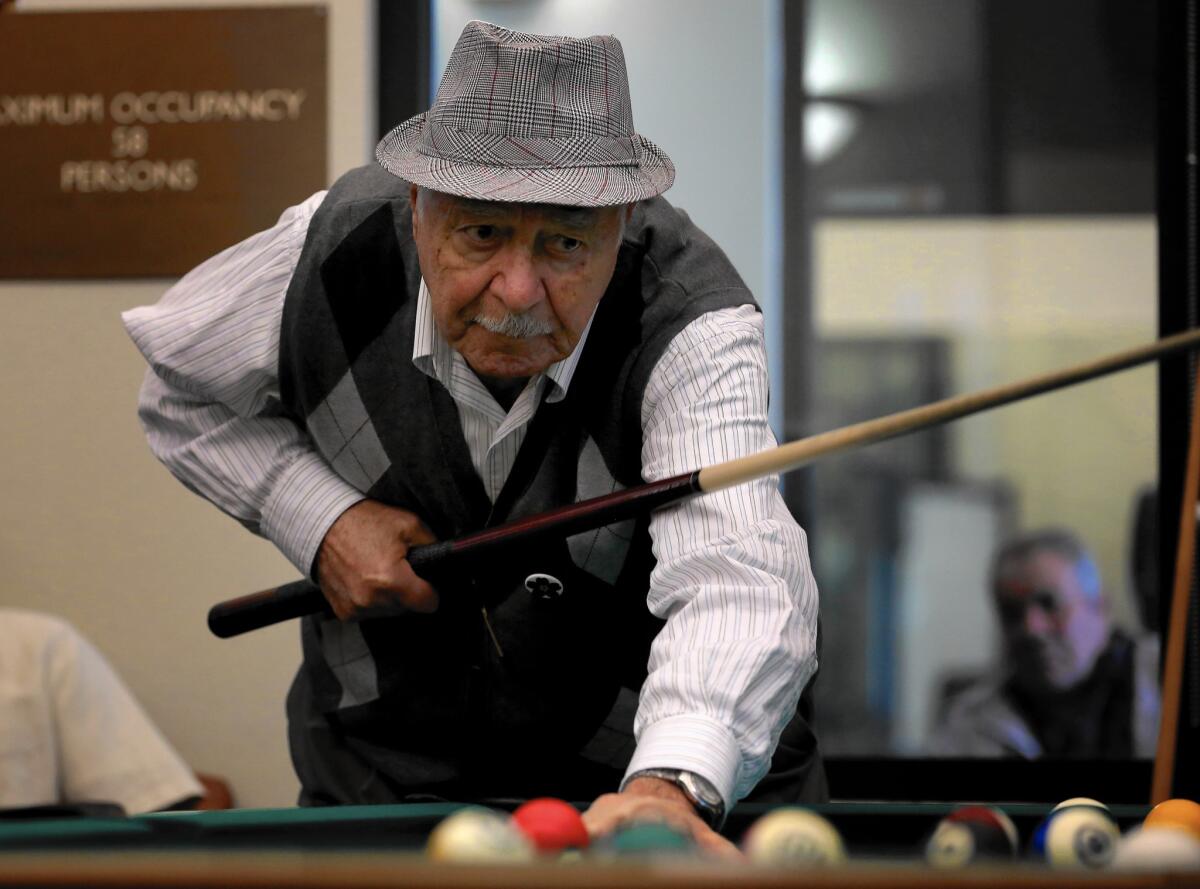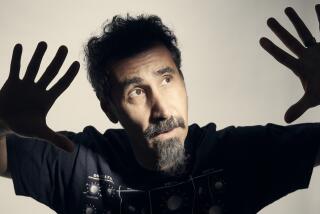Armenians recall tales of the past on centennial of genocide

Sarkis Ohanessian, 87, plays pool at the Adult Recreation Center in Glendale.
- Share via
Dapper men flock here by the dozens almost every day.
They arrive in sweater vests and fedoras, to play pool, backgammon and chess — until their wives call them home for lunch or dinner.
It would seem to be a sweet life they live in Glendale, home to the largest population of Armenians outside of Armenia.
Until the days leading up to April 24, the date marking the 1915 Armenian genocide, when about 1.2 million people in their homeland were massacred at the hands of Ottoman Turks.
“Every April, my heart beats faster,” said Vachagan Hovsepyan, 64, whose great-grandparents died during the genocide. “I wonder: Will this be the year we finally have justice?”
“The next day,” he said. “I’m always left empty.”
The atrocities happened so long ago — before the invention of television or penicillin — that some wonder why Armenians, now dispersed across the world, can’t simply just let go.
But moving on is impossible without recognition, Hovsepyan said.
This year, on the 100th anniversary of the slaughter, the Turkish government continues to deny that the killings were intended to exterminate a population and asserts that the numbers are exaggerated. And for the seventh consecutive year, President Obama declined to call the deaths a “genocide” — a term that Turkey, a strategically important ally, aggressively lobbies world leaders to reject.
The papiks of Glendale are grandfathers in their 60s, 70s and 80s who were not yet born when Ottoman leaders did the killing, suspecting Armenians of collaborating with their enemy, Russia. But their minds are full of stories, and at the Adult Recreation Center, where Armenian senior citizens have gathered for years, April brings those stories to the surface.
On Friday, most of the men could not participate in the six-mile march from Hollywood to the Turkish Consulate that tied up traffic along Wilshire Boulevard in the afternoon. Their legs ached, and backs were not strong enough. They planned to light a candle at home or at church instead.
On Thursday, the day before the anniversary, the center buzzed with the sound of Armenian. Old friends fired billiard balls into corner pockets, other hunched in groups of four over backgammon boards.
Some were born in Armenia, others in Lebanon, Iraq or Syria. Today, many wore a purple forget-me-not flower pin on their chest, the unifying emblem of the centennial.
News of the anniversary was inescapable, though some men said they would rather not discuss the subject. Images of relatives marched to starvation or thrown off cliffs were too much to bear, they said.
“Everyone has different emotions,” said George Keushkarian, 87, who said his great-uncle and great-aunt, children at the time, were burned alive when their village was set ablaze. “But for many of us, the pain lives in your skin and there’s nothing we can do about it.”
Some worry that amends will not come during their time and that younger Armenians, who did not hear the narratives directly from survivors, may not guard the tales of atrocity so closely.
Others know little because of the silence of their parents, so they struggle to find answers. Some turn to history books at the Glendale library next door.
On Thursday, Yervant Melconyan, 87, sat quietly chatting with a friend in the center’s lobby.
Melconyan will tell the story of his father, who survived, to anyone who will listen. He wrote each detail in a notebook that he keeps in a drawer in his bedroom.
He said that in 1915, Setrak Melconyan was marched by Turks to the desert, along with scores of other Armenians. His wife and Melconyan’s older three brothers, ages, 10, 8 and 6, were by his side.
“They gathered them in the middle,” Melconyan said. “And shot them all.”
Setrak hid beneath the corpses and managed to escape. He embarked, Melconyan said, on a months-long odyssey, starving and at times naked and beaten by mobs of Turkish villagers until he eventually found refuge in Iraq.
Later, when he returned to his village in eastern Turkey, he found that only one relative — a brother — had survived.
Melconyan, born from a second marriage and named after one of his older brothers who did not survive, said that the details haunt him, but that his life is peaceful now. He’s surrounded by his people, by Armenian grocery stores, bakeries and banquet halls.
One day he will pass along the notebook to his grandchildren. He has five of them, he said, proudly listing each of their names: “Yervant, Alin, Talin, Sevan and Narek.”
------------
For the Record
April 24, 8:23 p.m. A previous version of this story spelled the name of one of Yervant Melconyan’s grandchildren as Acin. It is Alin.
------------
esmeralda.bermudez@latimes.com
More to Read
Sign up for Essential California
The most important California stories and recommendations in your inbox every morning.
You may occasionally receive promotional content from the Los Angeles Times.














